
Pikes Peak — America’s Mountain, America the Beautiful, purple mountain majesties and all that. Something I’ve been wanting to do for some time is to ride it. With summer starting to wind down, it occurred to me that I better get cracking if I was going to do it this year.
But before getting into the meat of things, I would like to apologize in advance for the low quality and limited quantity of pictures in this post. In my early morning scramble to load up the car for the drive to Colorado Springs, focused on not forgetting any bike stuff (helmet, glasses, gloves, socks, shoes, wind shell, jacket, knee warmers, arm warmers, bike, pump, etc., etc.), I forgot my phone. Remembering that my Garmin Oregon can take pictures, that is what I used. While better than nothing, the pictures are definitely not iPhone quality.
The road up Pikes Peak is the second highest paved road in North America, just 15 feet lower than the highest, the road up Mt. Evans near Denver. It’s 19 miles from the gate at 7,660 feet to the summit at 14,115 making for some 6,455 feet of vertical. A 38-mile round trip is no big deal but that vertical and ending elevation sort of gets your attention. My two previous highest rides, Cottonwood Pass and Independence Pass top out at just over 12,000 feet. And even the Monarch Crest, a mountain bike ride, doesn’t break the 12,000-foot barrier.
This was going to be something different. I’ve hiked to 14,000 feet many times but riding that high? Never. I wasn’t sure how my lungs or my legs would react. But I wanted to find out. Anything worth doing is hard, right? That’s the theory anyway.
I left Salida at zero dark thirty to arrive at the town of Cascade at the bottom of Pikes Peak just before the gate opens at 7:30 a.m.. My plan was to park at the North Pole “Home of Santa’s Workshop”, a Christmas-themed amusement park with a huge parking lot about 100 yards before the gate.
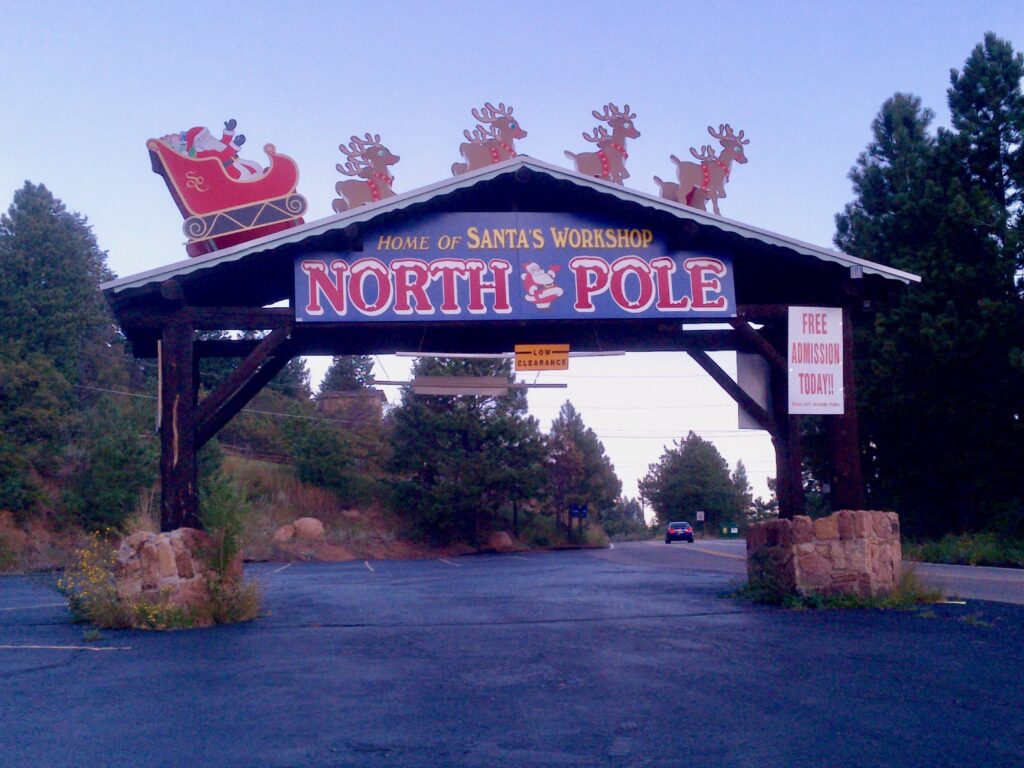
As a kid, this place thoroughly confused me. I was smart enough to know that Colorado is nowhere near the North Pole. But why would they have all these signs saying it was the North Pole if it wasn’t true? Are the grown ups lying? Look, there’s Santa, it must be real. My parents gave me some story about it being a “branch office” of the workshop at the actual North Pole, but I was skeptical.
When I arrived for my ride, I found the North Pole parking lot ringed by numerous large threatening signs saying “North Pole parking only. Others will be towed at owners’ expense.” So despite the fact that it was Wednesday and the North Pole was closed for the day, despite the fact that they had hundreds of empty parking spots and I only needed one for a few hours, I decided not to risk it. I figure Santa is probably just the type of hardline capitalist that would tow an illegally parked car, even on his day off.
So I headed up the road to the gate. Obviously, most people going up Pikes Peak drive so there is no need for parking at the entrance. But from doing a Google Street View the night before I could see there were maybe a dozen spots right at the gate. At 7:00 in the morning I figured there was a good chance there would be something available. When I got there there were a handful of cars in the employee parking and three or four in the remaining spaces. I pulled into an unmarked spot next to another car and proceeded to unload.
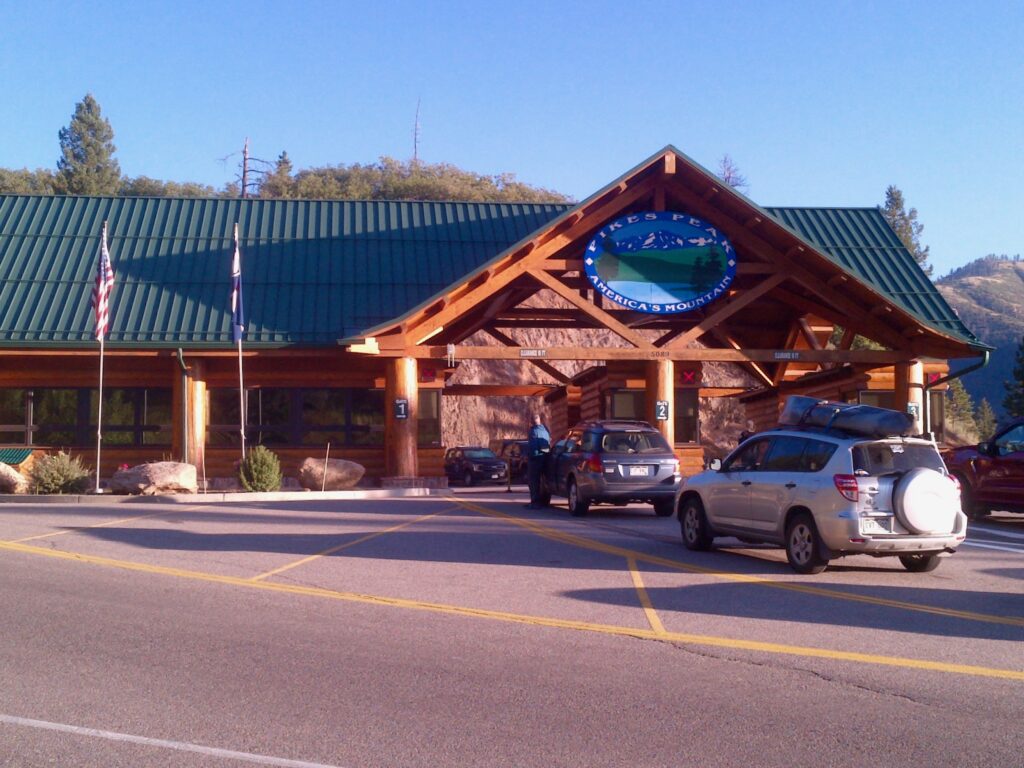
It’s $15 per person to climb Pikes Peak. Due to space limitations on the summit, cars have to make a reservation. Bikes just have to pay the 15 bucks. I got in line with the cars and when my turn came, I rolled up to the man at the window, paid my money and got my official pink wrist band authorizing me to ride up.
And let me tell you, when it comes to climbing, Pikes Peak doesn’t fool around. Immediately after the gate there’s a lefthand switchback and bang, you’re climbing. Steeply. For miles.

I’m not the best judge of gradient but the Pikes Peak road is steeper than anything paved I’ve climbed in Colorado. Mountain passes like Cottonwood and Independence typically have signs that indicate grade and I don’t remember seeing any of them greater than 7 – 8%. Pikes Peak is definitely steeper than that. It felt more like passes in Europe. I’ve had the privilege to ride some of the Tour de France climbs in the Alps and to me Pikes Peak feels more like that, so probably 9 – 10% at its steepest points.
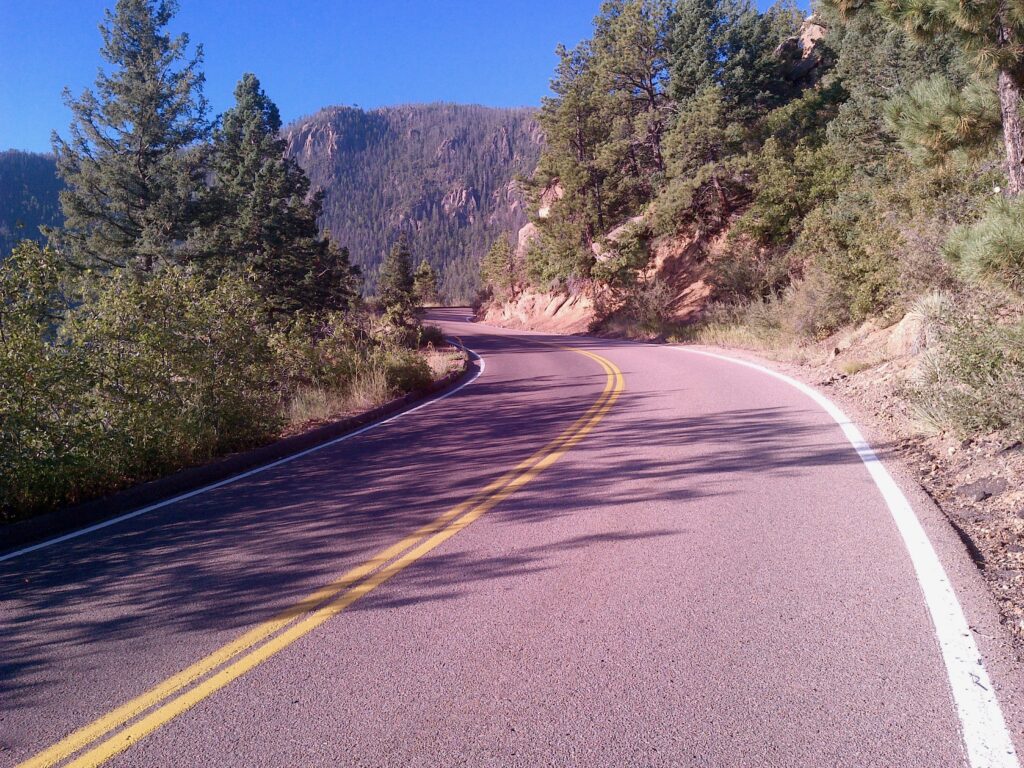
The difference, of course, is the altitude. The Col du Galibier, one of the higher passes used in the Tour, a climb of similar length and vertical as Pikes Peak, tops out at 8,668 feet. On Pikes Peak you pass that altitude in the first two miles of the ride.
Not to mention, the whole time you need to stay alert for Big Foot.
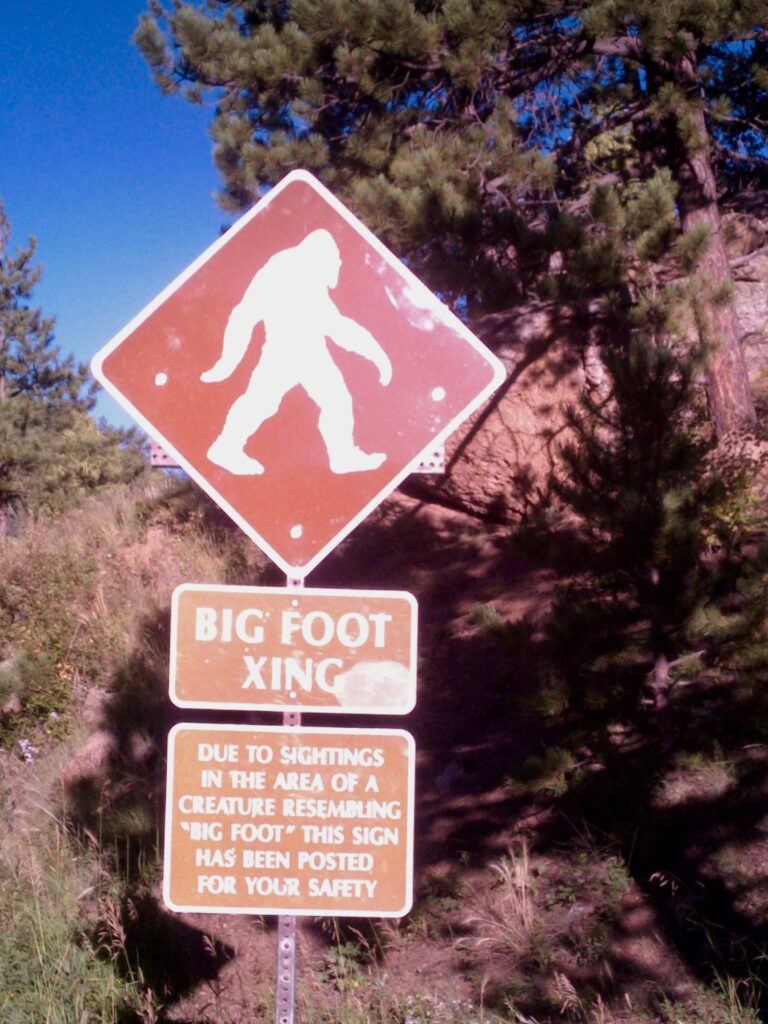
From the gate the road climbs steadily up to around 9,300 feet where you’re given a short downhill to Crystal Creek Reservoir.
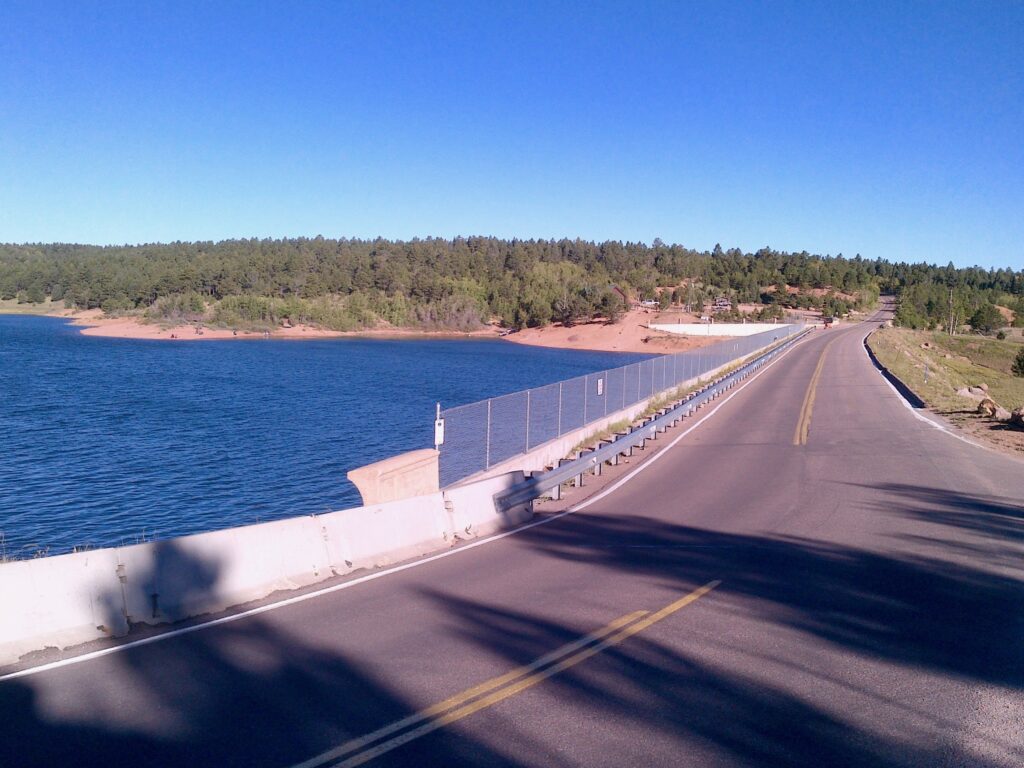
Past the reservoir, there are a couple more miles of gently climbing terrain to give your legs a break.

Then at around 10,000 feet the road tips up steeply and doesn’t relent for the next many miles.
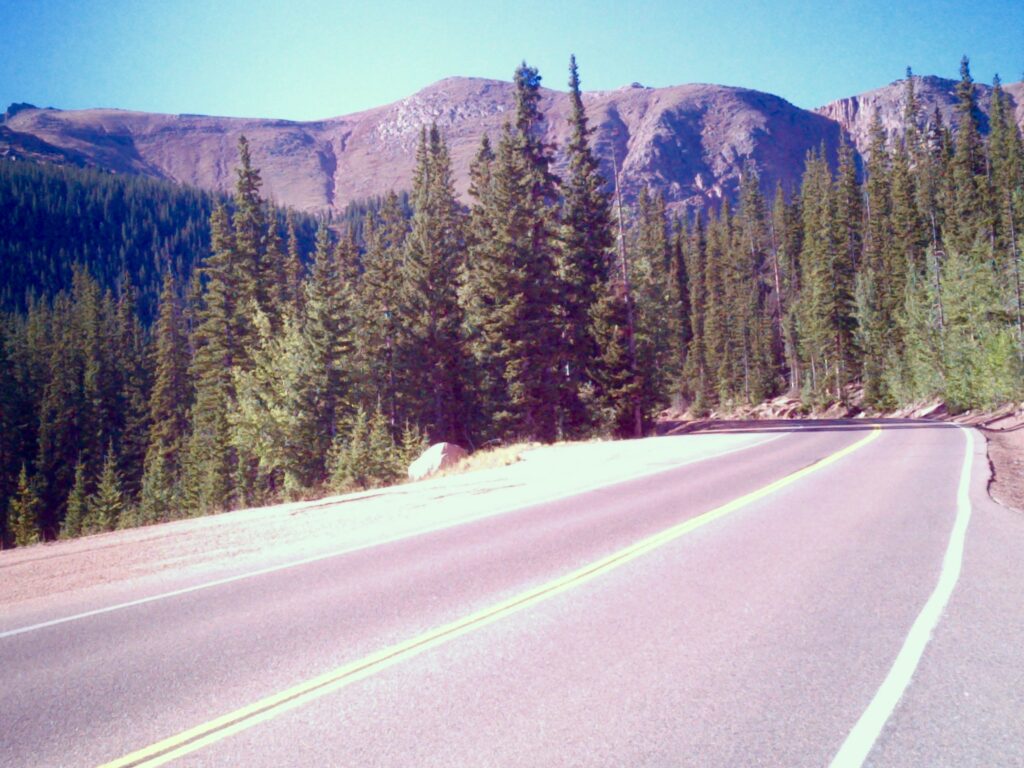
There are mile-marker signs all the way up featuring various animals native to the region.

At 11,450 feet (there’s an elevation sign above the door) I reached the historic Glen Cove Inn. The sign at the gate said “Proceed On” so I did.
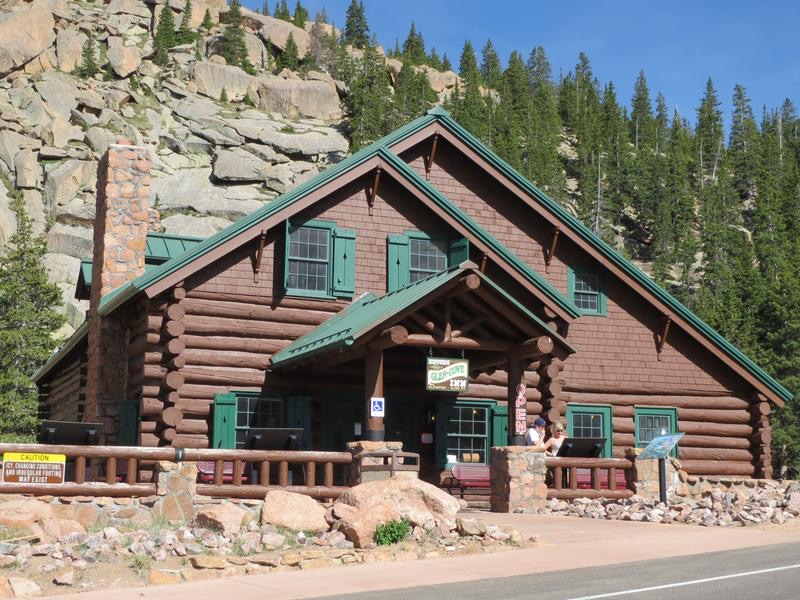

Shortly above the Glen Cove Inn, at around 11,800 feet, the road breaks above timberline and begins a series of tight switchbacks. You can see several of them carved into the mountain face in the center of this photo.
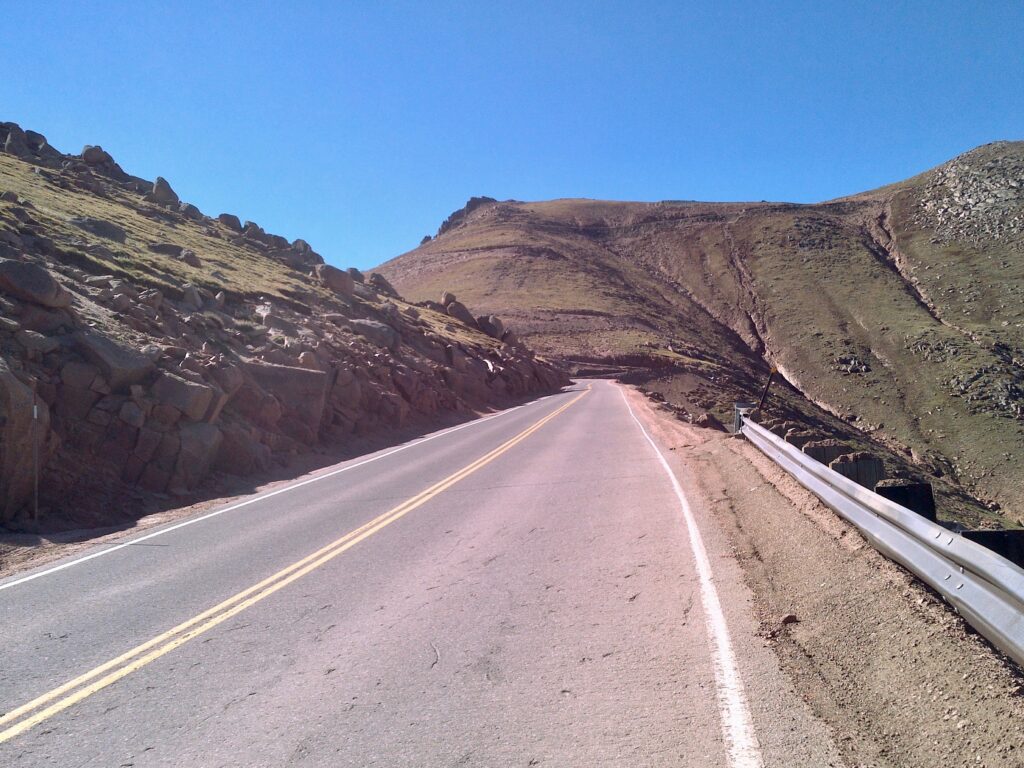
Out of the trees and onto the exposed upper slopes, the wind became a big factor. No matter which way the road turned it seemed like there was always a head or crosswind. The headwinds sucked but the crosswinds were almost worse. At least twice, a gust caught my front wheel and threw me a foot off my line toward the edge. If your heart rate isn’t already up, that’ll do it.
At 12,200 feet approaching the Devil’s Pinnacles.

More switchbacks.
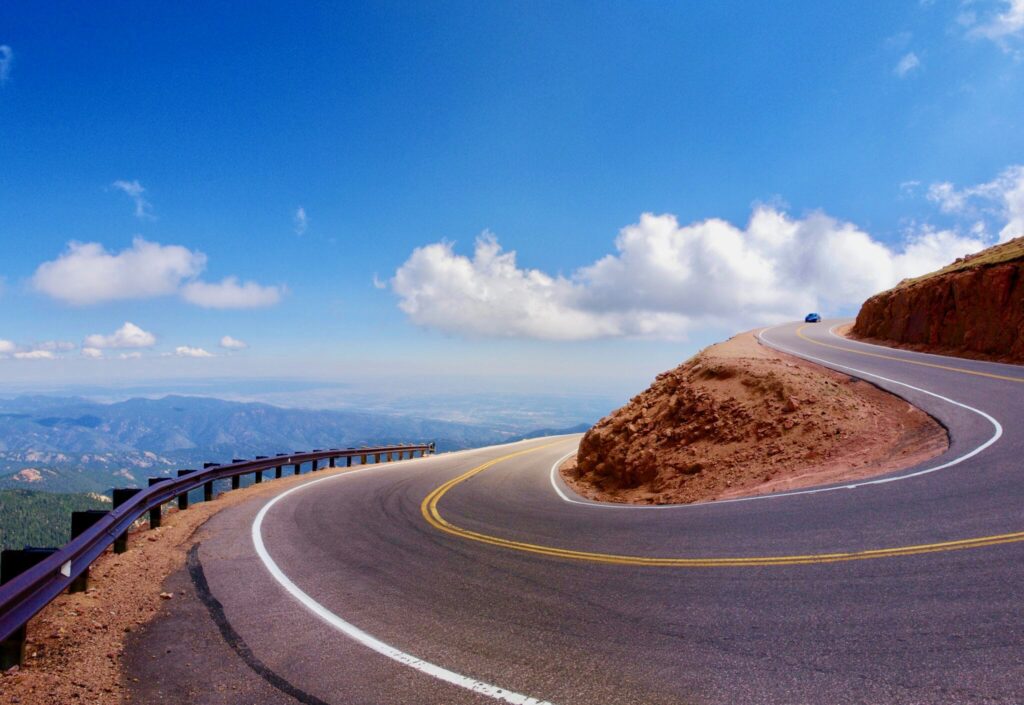
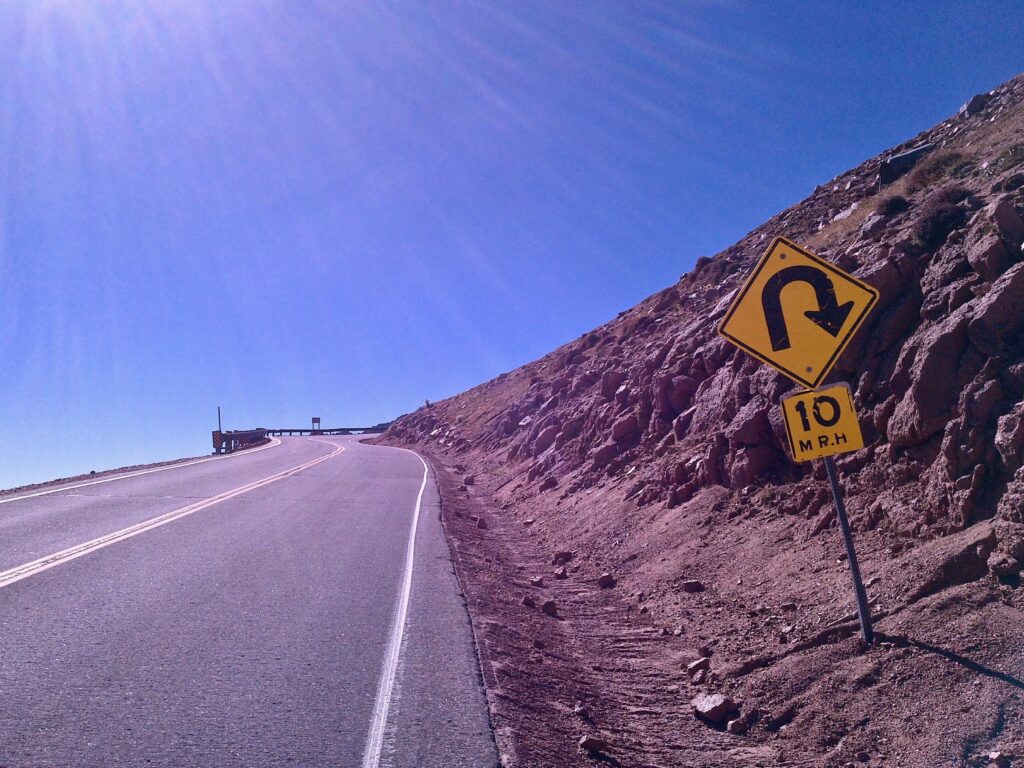
12,800 feet, looking back down on the switchbacks I’d just climbed.
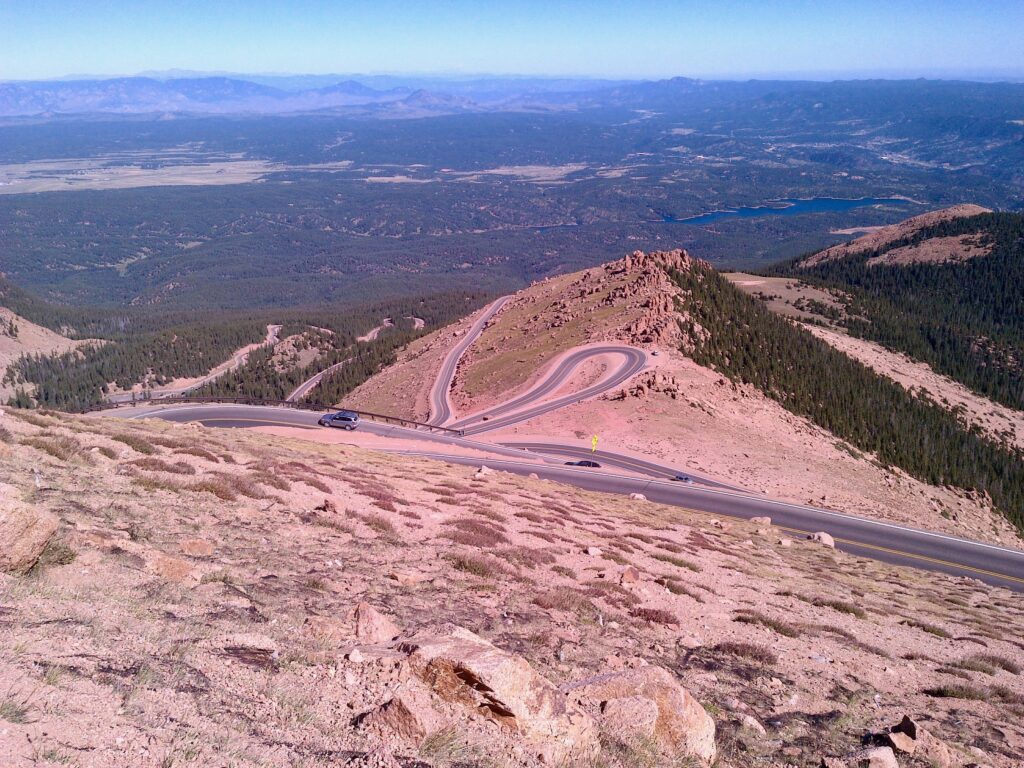
At 12,950 the road curves left and climbs onto a relatively flattish saddle known as the Devil’s Playground. Why is it always the Devil in the mountains?

The grade eased considerably and I could peddle harder without becoming asphyxiated. Obviously, a welcome relief but also somewhat problematic because it looked and felt like I was almost to the top and I started to relax a bit.
Then two bad things happened. The road curved around Pikes’ northwest ridge, giving me a clear view of the remaining 1,000 feet of exposed climbing still ahead and it descended 100 feet or so adding to my altitude deficit. Yeah, fairly soul crushing.
That last 1,000 feet to the summit is by far the toughest. It includes some of the steepest grades of the climb, too steep for me to climb sitting down. Pedaling standing up allows you to put more power to the pedals but is more aerobically demanding. At 13,000+ feet there isn’t enough oxygen for heart and lungs to function properly so standing would quickly result in me maxing out my heart rate. I had to stop every few hundred feet to bring my heart rate back down before continuing.
Plus, it was really hard to tell exactly where the top was. I could see I was close but at least twice I was sure it was just around the corner only to have the road switch back and keep climbing.
But after four hours of effort, I finally reached the summit. From a high-mountain perspective, Pikes Peak’s summit is strange. It’s literally a parking lot. A parking lot with a visitor center, restaurant, gift shop and restrooms. They just opened a new visitors center this summer and it’s really nice. But it’s weird. I’m used to 14er summits feeling wild and somewhat dangerous. Pikes’ summit is like rolling up to any other tourist attraction with cars, crowds and basically, civilization. But I wasn’t complaining. It was nice to sit down and have something to eat out of the wind.
Shiny new visitors center.
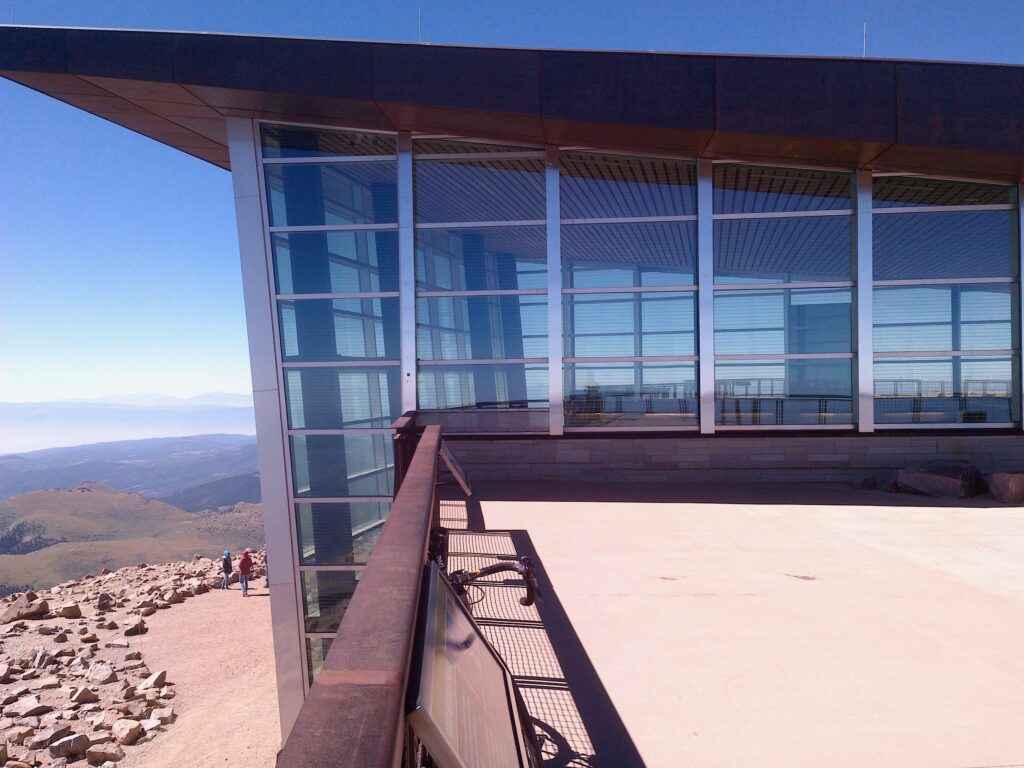
Colorado Springs from the summit.
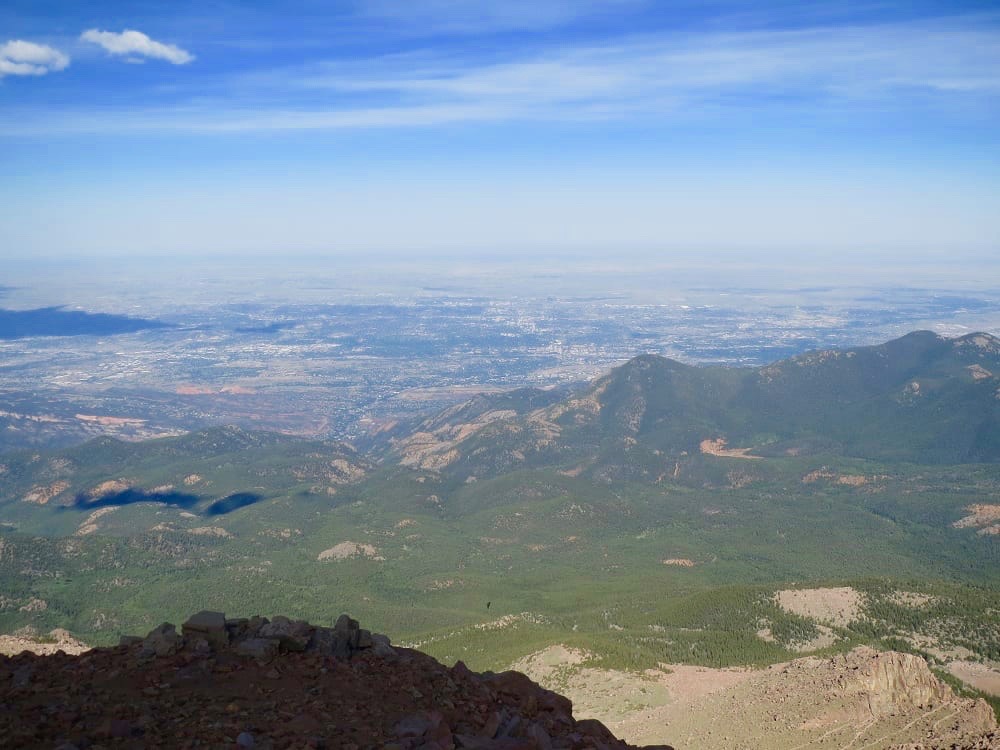
The view southeast with Lake Moraine in the foreground.
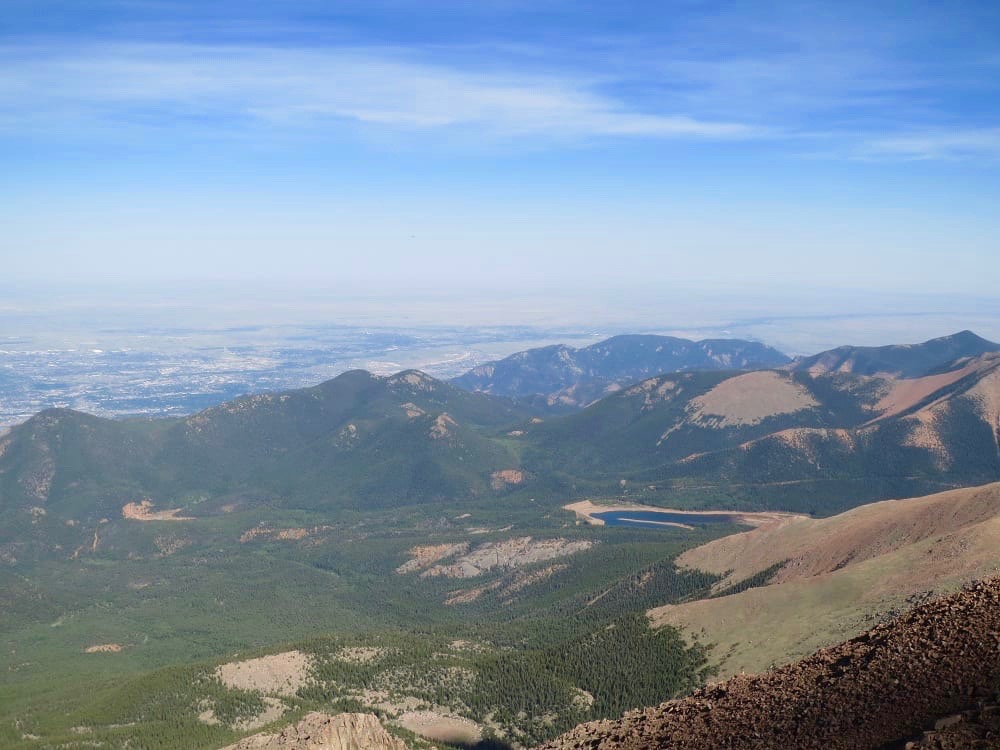
Not to mention, I felt like a minor celebrity. Virtually everyone up there had passed me on the way up in their cars. And a whole bunch of them wanted to talk to me. What kind of bike is that? What gears are you running? Where are you from? How old are you? Have you done this before? It was kind of entertaining.
The best was when I rolled over to the summit marker for a picture. There was a large family there, obviously from India at some point in their history, and when they saw me, they gathered around and started peppering me with questions. How long did it take you? What did you eat? Can we take your picture? Then a tiny, older lady, wearing a colorful sari and sporting a bindi on her forehead, the matriarch of the family I assumed, pushed her way past the others to say “I want a picture with you!” I felt like Brad Pitt.
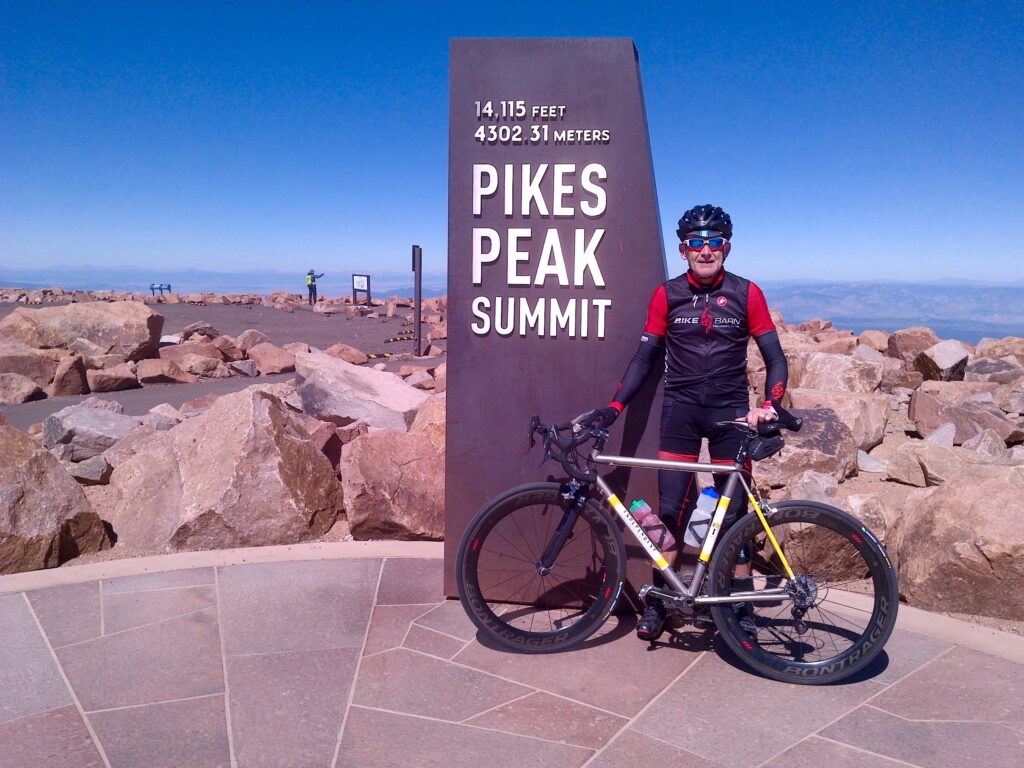
More pictures were taken. Thank yous were exchanged. I said goodbye and started my descent.
I took the first part of the descent slowly. Because of the gusting crosswinds I didn’t have the nerve to go over about 20 mph. Not wanting to hold up cars, I pulled over multiple times to allow them to pass and to give my brake fingers a rest. But once I got below the Devil’s Playground and back into the trees, I felt more confident letting the bike roll at the speed gravity dictated.
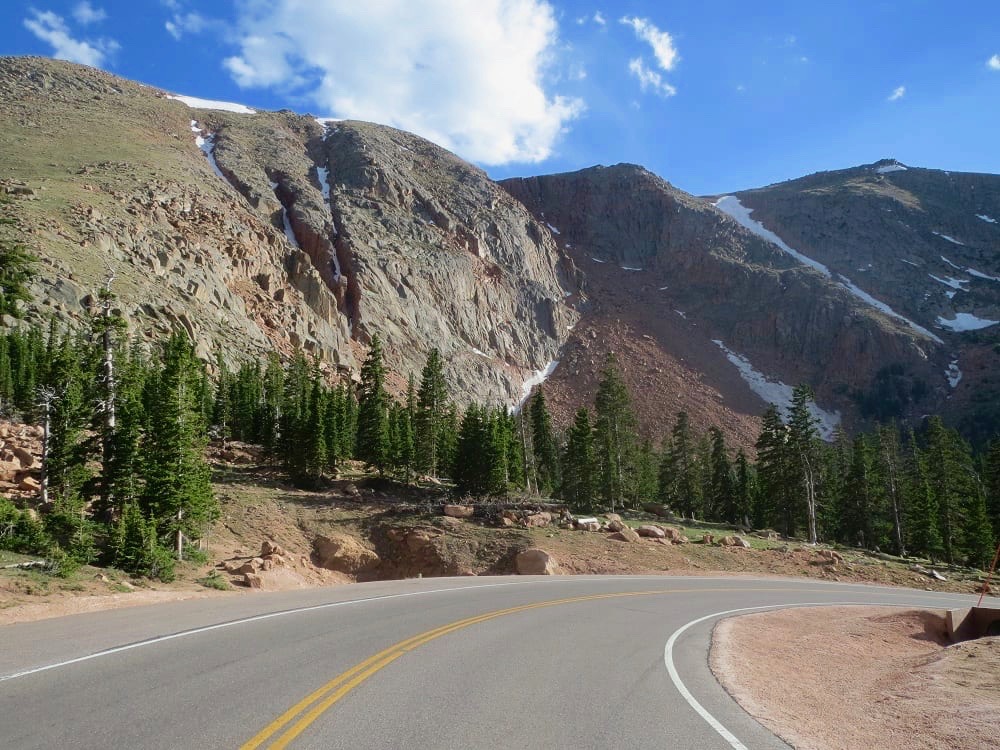
Back at Glen Cove they have a mandatory brake check for all vehicles heading down. They check the temperature of your brakes and if they’re too hot they make you pull over and wait for a few minutes. For safety, I’m sure. But also, I imagine, a pretty lucrative income stream for the Glenn Cove restaurant and souvenir shop. Me, on a bike? They just waved me through.

The last half of the descent was a blast. The speed limit is 30 mph and with the tight turns, cars have a hard time even going that speed. It was easy to keep up with traffic and several times I had to resist the temptation to pass.
I was back at the gate before I knew it. The four-hour climb had taken me an hour to descend. Back down at 7,600 feet it was warm and sunny with no wind. It felt great. I loaded my bike and gear into the car for the drive home, tired but happy.
Back in Salida, time for a beer and a recovery soak.
